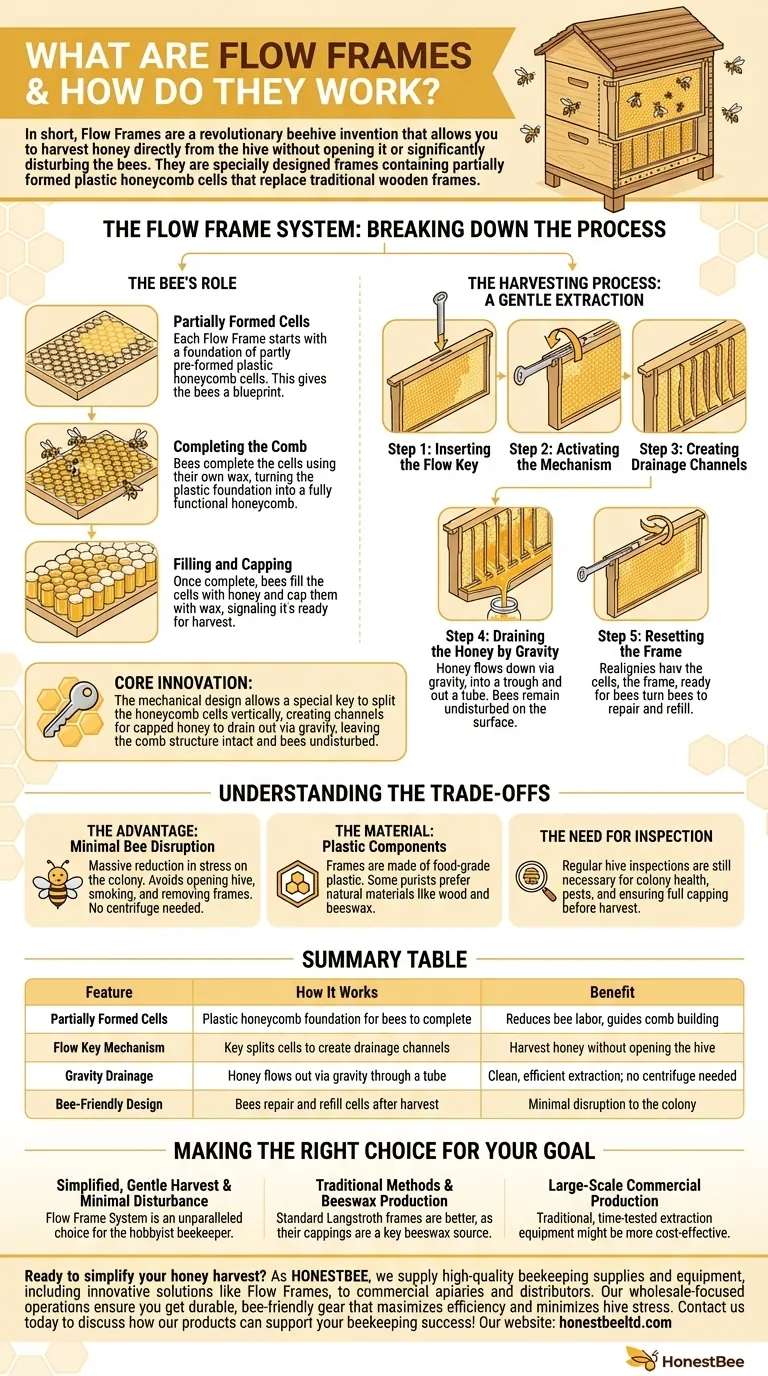In short, Flow Frames are a revolutionary beehive invention that allows you to harvest honey directly from the hive without opening it or significantly disturbing the bees. They are specially designed frames containing partially formed plastic honeycomb cells that replace the traditional wooden frames inside a beehive's honey super.
The core innovation of a Flow Frame is its mechanical design. A special key is used to split the honeycomb cells vertically, creating channels that allow pure, capped honey to drain out via gravity, leaving the comb structure intact and the bees undisturbed.

How the Flow Frame System Works
To truly understand the value of this system, it's best to break down the process from the bee's perspective and then the beekeeper's.
The Bee's Role: Building and Filling the Comb
Partially Formed Cells
Each Flow Frame starts with a foundation of partly pre-formed plastic honeycomb cells. This gives the bees a blueprint to build upon.
Completing the Comb
Just as they would on a traditional frame, the bees get to work. They complete the cells using their own wax, turning the plastic foundation into a fully functional honeycomb.
Filling and Capping
Once the comb is complete, the bees fill the cells with honey. When the honey has ripened to the correct moisture content, they cap the cells with a final layer of wax, sealing it for storage. This is the sign that the honey is ready for harvest.
The Harvesting Process: A Gentle Extraction
This is where the Flow Frame design fundamentally changes the beekeeping experience. The process is clean, simple, and happens outside the hive.
Step 1: Inserting the Flow Key
A long tool, the Flow Key, is inserted into an operating slot at the top of the frame from the outside of the hive.
Step 2: Activating the Mechanism
The key is turned 90 degrees. This simple action engages the internal mechanism of the frame.
Step 3: Creating Drainage Channels
Turning the key causes the two vertical halves of each cell to shift slightly. This movement breaks the wax capping and splits the cells, transforming the sealed honeycomb into a series of open channels running down the frame.
Step 4: Draining the Honey by Gravity
With the channels open, gravity takes over. The fresh, pure honey flows down through the frame into a sealed trough at the bottom and then out of the hive through a tube, directly into your jar. The bees remain on the comb's surface, barely noticing the event.
Step 5: Resetting the Frame
Once the honey has drained, the Flow Key is turned back to its original position. This realigns the cells, which the bees will then repair and refill with honey, starting the process all over again.
Understanding the Trade-offs
While the system is innovative, it's essential to understand its context within beekeeping.
The Advantage: Minimal Bee Disruption
The primary benefit is a massive reduction in stress on the colony. Traditional harvesting requires opening the hive, smoking the bees, removing frames, and using machinery like centrifuges to extract honey. The Flow system avoids all of this.
The Material: Plastic Components
The frames are made of food-grade plastic. While effective, some beekeeping purists prefer to use only natural materials like wood and beeswax in their hives.
The Need for Inspection
Flow Frames do not eliminate the need for regular hive inspections. A beekeeper must still monitor colony health, check for pests, and ensure the frames are completely capped before harvesting to get properly cured honey.
Making the Right Choice for Your Goal
Deciding on a hive system depends entirely on your beekeeping philosophy and objectives.
- If your primary focus is a simplified, gentle harvest with minimal disturbance: The Flow Frame system is an unparalleled choice for the hobbyist beekeeper.
- If your primary focus is traditional methods and beeswax production: Standard Langstroth frames will be a better fit, as their cappings are a key source of beeswax.
- If your primary focus is large-scale commercial production: The cost and mechanics may lead you to stick with traditional, time-tested extraction equipment.
Ultimately, Flow Frames represent a brilliant tool designed to make honey harvesting dramatically easier and safer for both the beekeeper and the bees.
Summary Table:
| Feature | How It Works | Benefit |
|---|---|---|
| Partially Formed Cells | Plastic honeycomb foundation for bees to complete | Reduces bee labor, guides comb building |
| Flow Key Mechanism | Key splits cells to create drainage channels | Harvest honey without opening the hive |
| Gravity Drainage | Honey flows out via gravity through a tube | Clean, efficient extraction; no centrifuge needed |
| Bee-Friendly Design | Bees repair and refill cells after harvest | Minimal disruption to the colony |
Ready to simplify your honey harvest?
As HONESTBEE, we supply high-quality beekeeping supplies and equipment, including innovative solutions like Flow Frames, to commercial apiaries and distributors. Our wholesale-focused operations ensure you get durable, bee-friendly gear that maximizes efficiency and minimizes hive stress.
Contact us today to discuss how our products can support your beekeeping success!
Visual Guide

Related Products
- 7 x Auto Bee Flow Hive Frames Plastic Beekeeping Hive Box Supplies
- Electric Honey Press Machine for Squeezing Honey Comb Press Equipment
- 10L Stainless Steel Electric Honey Press Machine
- Plastic Bee Frame Beekeeping Hive Frames for Wholesale
- Heart-Shaped Comb Honey Frame and Honeycomb Cassette
People Also Ask
- What do bees do after the comb is reset in Flow Frames? Maximize Your Hive's Honey Production Efficiency
- How do you clean plastic frames? A Gentle Guide to Preserving Your Frames
- How long does it take for bees to fill a Flow Hive? A Guide to Realistic Timelines
- What is the selling point of the Flow Hive? A Revolutionary, Stress-Free Honey Harvest
- What are the main parts of a hive frame? A Guide to Modern Hive Anatomy



















